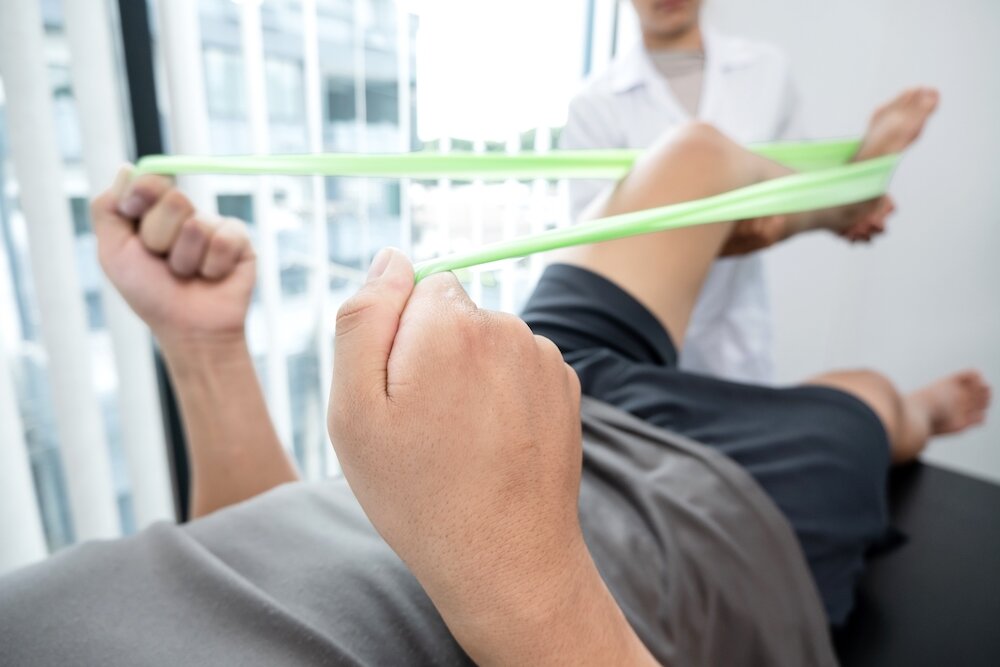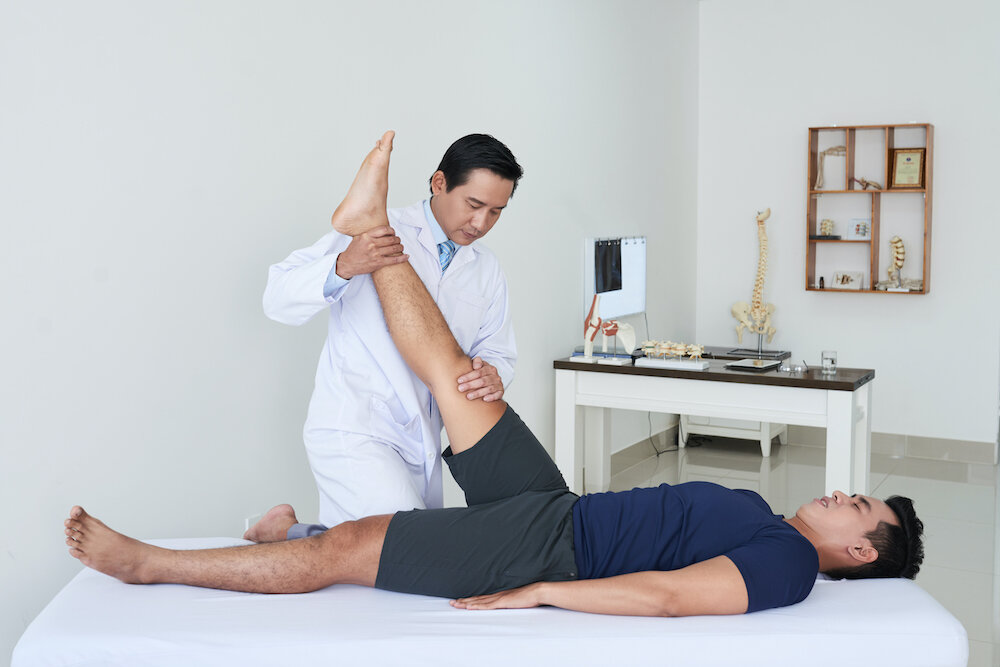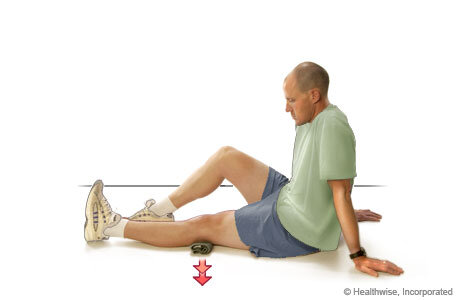ACL Rehabilitation Protocol: What to do after surgery
Brief ACL background
The Anterior Cruciate Ligament or the ACL, is one of the most notorious structures in the lower limb. Many who follow sport know that athletes who face this career jeopardizing injury require substantial rehab and often surgery. Tom Brady, perhaps one of the greatest quarterbacks of all time, was struck during the first game of the 2008 NFL season. He required reconstructive surgery and a regimented physical therapy program for one year to return safely the following season. He continues his long and incredibly decorated career thanks to exceptional medical management and physical rehabilitation. ACL tears are common during situations where a sudden stop and/or change in direction occurs (Mayo Clinic Staff, 2019; AAOS, 2014). Our expert physiotherapy team is here to help and provide some insight on how to manage this pain so you can get back to the things you love.
Anatomy of the ACL
The ACL originates from the anterior tibia and attaches onto the posterior aspect of the femur (femoral condyle) to “help stabilize the knee joint” (Mayo Clinic Staff, 2019). Cruciate is taken from the latin word “crux” for “cross”, as this is the orientation of the ligament in the knee.
Mechanism of Injury
The way that the ACL is injured is classically non-contact, and the result of excessive knee valgus, hip adduction and internal rotation of the lower limb. We see many as a result of sport, in which a sudden “twist” if the knee results in injury. There are several theories that have been accepted to describe why certain individuals suffer this injury and are more prone to it.
There are 4 theories of why an ACL injury occurs:
The ligament dominance theory:
This theory suggests that female athletes at high risk perform athletic maneuvers with excessive knee valgus, hip adduction, and hip internal rotation.
Quadriceps dominance theory:
This theory suggests that excessive relative quadriceps forces or reduced hamstring recruitment place the ACL at high risk for injury.
Trunk dominance theory:
This theory suggests that poor trunk control during athletic maneuvers leads to increased risk for ACL injury.
Leg dominance theory:
This theory suggests that large leg-to-leg asymmetries predispose athletes to injury. Support for these theories has been provided by biomechanical, video analysis and cadaveric studies.
The cause of an ACL injury may have all, some, or one of these theories at play. A dynamic biomechanical assessment may help reveal which factors should be corrected in a patient to reduce reianjury risk.
Diagnosis of an ACL Injury
Diagnosis of an ACL injury requires the expertise of a health professional. If possible, it is best to have it examined immediately after injury. The presence of swelling and pain can often lower the sensitivity and specificity of manual tests. Computerized tomography or CT may be able to provide clarity if it is not a complex case (involving more than one injury) and there is minimal hemarthrosis and swelling. The gold standard for diagnosis will be Magnetic Resonance Imaging or MRI. Simple X-Rays/Radiographs will not provide enough clarity to gather accurate findings for a diagnosis. Imaging is usually recommended with high clinical suspicion based on mechanism of injury and manual testing.
How long does it take or how many days does it take to rehab a torn ACL after surgery?
Returning to sport or activity too soon poses a substantial risk of reinjury. Many professional athletes may aim to safely return to play within 6 to 9 months. However, many protocols often cite a rehabilitation period closer to 12 months to reduce risk of reinjury. We know from both animal and human studies .
That the time it takes for the integration, proliferation, and remodelling of a graft takes at least 12 months. Vascularity to the ACL returns to normal at 6-12 months, however the failure load and stiffness of the ligament will remain at 50-60% of a non-operative ACL well after 12 months.
The amount of time taken for rehabilitation will vary between individuals based on intrinsic factors such as their level of fitness prior to injury, coordination, genetics, and motivation. Extrinsic factors such as attending a structured rehabilitation program, occupational demands, and socioeconomic level may influence prognosis.
It is important to note that an ACL reconstruction will often use a tendon graft from either the hamstring or patella. This will come from the patient. Using a biological graft from the patient is standard practice. In the first 4 weeks the graft will begin healing into the site of the ACL. This is analogous to rooting plants from branch cutting. The branch cutting will need time to set into it’s new environment with the appropriate nutrients in order to grow. The graft is mechanically weakest at 6-8 weeks post operatively based on both animal and human biopsy studies. The graft needs to be loaded enough to stimulate growth, just as a plant needs water to grow. However excessive loading may cause the graft to fail/rupture – just as watering a plant excessively will cause it to drown. It is therefore important to work closely with qualified medical professionals to ensure you are adhering to post-operative guidelines.
What does rehabilitation of an ACL injury look like?
The period of rehabilitation will vary for everyone based on their age, previous activity levels, if they have undergone surgery, concurrent/prior injuries, and motivation. ACL recovery rehab may include strengthening exercises for one’s leg, hip/pelvis, and core region, as well as correcting training errors through proprioceptive and plyometric exercises for pivoting, jumping, and landing (Mayo Clinic Staff, 2019). Initially, it is important to rest the limb, apply ice around the joint, compress the joint, and elevate the limb (Mayo Clinic Staff, 2019).
Typically, rehab starts with the restoration of motion within the knee and other associated tissues (AAOS, 2014; Wedro, 2019), which includes knee extension exercises with the possible help coming from knee extension machines. After the range of motion is back, strengthening of the muscles usually come next (AAOS, 2014; Wedro, 2019). For example, isokinetic exercises may be incorporated, hamstring strengthening exercises, knee strengthening exercises, etc.
Finally, the last step would be to restore the function of the injured region through functional daily activities and/or sport specific activities (AAOS, 2014; Wedro, 2019).
Early Phases (0-9 weeks)
Goals:
Decrease pain
Reduce swelling
Increase knee range of motion
Maintain range of motion of hip and ankle
Activation of quadriceps muscle
Maintain cardiovascular fitness
It is important to restore and maintain range of motion early on. Full or “terminal” extension is an especially important outcome. In post-operative patients, this does not put their graft at risk.
Education on prognosis, outcomes, and lifestyle changes is important to establish during this period. A substantial part of rehab will be understanding what it means to live with an injury in the upcoming months.
As mentioned above, an ACL reconstruction uses a graft. It is imperative to encourage correct loading of the graft during this phase with specific exercises. If there is excessive load on the graft it may fail, and the surgery will therefore be unsuccessful.
Physiotherapy will aim to begin activation of the quadriceps muscles through activities such as “quads setting”. This can be facilitated using modalities such as neuromuscular electrical stimulation (NMES) to help increase muscle contraction.
It is vital to begin proprioceptive/balance re-education early on within the given weight-bearing guidelines. ACL injuries create deficits in joint position sense (also known as proprioception) in the injured limb compared with the uninjured limb and control groups.
It is imperative to work closely with a physiotherapist in the initial phase to reduce the risk of rupturing the graft and ensuring an effective recovery.
Intermediate Stages of Rehab 9-16 Weeks:
Goals:
Achieve full knee range of motion
Improve Quadriceps strength
Strengthen the lower limb
Begin Sport specific balance training
Begin Sport specific cardiovascular training
Studies have shown that from Weeks 8-12 the graft will begin to proliferate and become stronger. This is when it is generally safer to increase the amount of loading. It is important to resolve any strength deficits at the site of where the graft was harvested (i.e. the hamstring or patellar tendon). At this stage most of the activities should be performed towards full range of motion.
For instance, the forward lunge is a very effective and classic exercise. This can be challenging for a patient to maintain their balance, address strength issues (in hamstrings, glutes, and quads), and coordination deficits.
Late Stages of Rehab 16-24 Weeks
Goals:
Improve functional coordination of lower limb
Continuing to strengthen the lower limb
Begin Sport specific Quadriceps strengthening
Begin plyometric activities
Begin low impact, non-contact sport specific drills
In the late stages of rehabilitation, the goals are to reintroduce sport/activity specific training. At this stage, it is encouraged to continue to increase strength and begin moving towards more dynamic and plyometric activities. This means activities such as jumping, hopping, running, and other specific dynamic movements relevant to the patient may be a part of the rehabilitation program.
Exercises such as lateral bounding on and from a single leg may help neuromuscular control and confidence with sport specific activities. These activities should be aimed at improving strength, coordination, and confidence back to what their previous activities are.
The total time for rehabilitation will exceed 24 weeks however after this stage patients should be able to continue with rehabilitation independently as many of their day-to-day functional activities should be restored at this stage.
What should be prevented in ACL rehab?
During the ACL rehab protocol, it is extremely important to avoid over stressing and under stressing the tissues/region (Wedro, 2019). You may think of this like a goldilocks principle: you don’t want too much, but you don’t want too little. Too much loading risks re-injury, and in severe cases re-rupture. Too little loading (or too much rest) and patients fail to achieve functional and pain outcomes – they aren’t able to return to work or normal activities as quickly.
When do you start rehab after ACL repair and how long does it take to bend your knee after surgery?
Rehabilitation starts immediately after the surgery, patients are given exercises to perform after (surgery) in the recovery room (Emory Healthcare, 2019). However, within the first 2 weeks after the surgery, the focus is on allowing the swelling to go down and to regain the ability to extend one’s knee (Emory Healthcare, 2019). Typically, elevating one’s leg, icing one’s leg, and riding a stationary bike occur during the first 2 weeks (Emory Healthcare, 2019). After these 2 weeks, the focus would be on obtaining full extension of one’s knee and increasing one’s quadricep muscle strength (Emory Healthcare, 2019).
Summary
In summary, the ACL is present in each of the knees and is a vital structure in knee stability. ACL tear or sprains are common within athletes and those that stop suddenly and/or was pivoting. ACL ruptures require surgery and extensive rehabilitation pre- and post-operatively. It is extremely important that one seeks the medical care they require if they believe their ACL has been sprained or torn. Medical professionals such as physiotherapists guide and develop the rehabilitation process, which can include knee rehab and/or hamstring rehab exercises. The ACL surgery recovery timeline can vary between individuals and should be followed carefully without over-straining or under-straining the injured region.
By taking the appropriate steps and beginning treatment early you should be able to return to activities safely as early as 6 months in some cases.
If you’re unsure of what to do, an expert opinion is always the best option. Our physiotherapists are available to thoroughly investigate this condition, the cause, and what best you can do to get back on the right track!
Read Related Articles
References
AAOS. (2014, March). Anterior Cruciate Ligament (ACL) Injuries. OrthoInfo. https://orthoinfo.aaos.org/en/diseases--conditions/anterior-cruciate-ligament-acl-injuries
Emory Healthcare. (2019). Rehab Timeline Expectations. Emory Healthcare. https://www.emoryhealthcare.org/centers-programs/acl-program/recovery/rehab-timeline.html
Mayo Clinic Staff. (2019, March 30). ACL injury. Mayo Clinic. https://www.mayoclinic.org/diseases-conditions/acl-injury/diagnosis-treatment/drc-20350744
Mayo Clinic Staff. (2019, March 30). ACL injury. Mayo Clinic. https://www.mayoclinic.org/diseases-conditions/acl-injury/symptoms-causes/syc-20350738#:~:text=An%20ACL%20injury%20is%20a,basketball%2C%20football%20and%20downhill%20skiing.
Ross, M. D., Hooten, S., & Moore, D. (2002). Lower Leg Girth and Ankle Plantar-Flexor Endurance After Anterior Cruciate Ligament Reconstruction. Journal of sport rehabilitation, 11(2), 128-138. 10.1123/jsr.11.2.128
Wedro, B. (2019, December 12). Torn ACL (Anterior Cruciate Ligament Tear). MedicineNet. https://www.medicinenet.com/torn_acl/article.htm
















